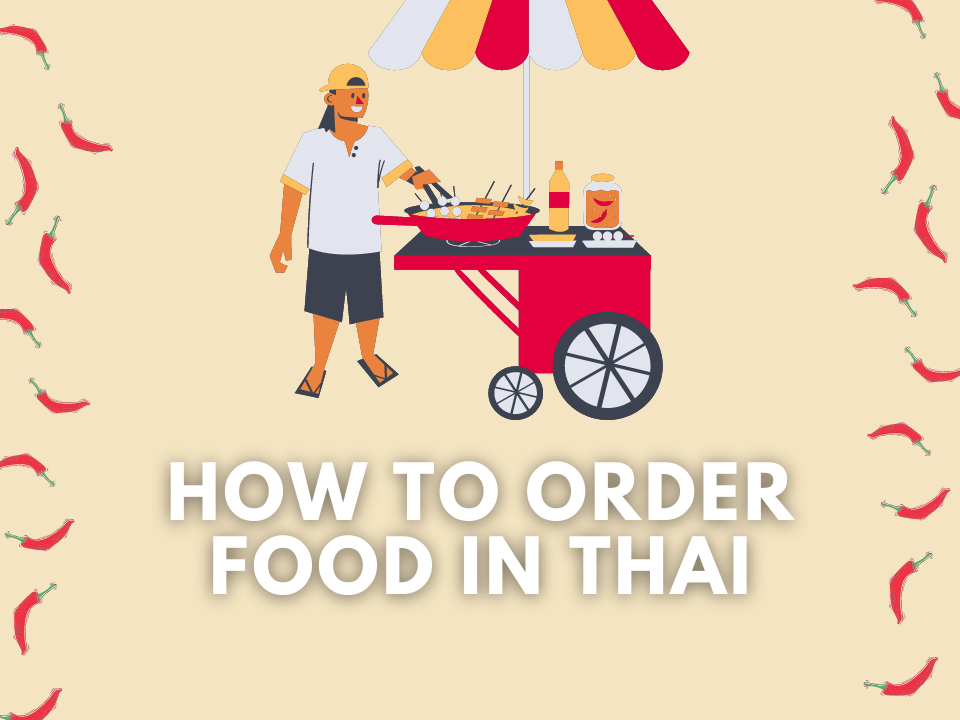Ordering food in Thai is a very necessary skill that you need to learn when visiting. Thai food is amongst the most popular in the world – and for good reason. There are so many flavors and tastes that make up the cuisine in Thailand, so there is a lot of variety. There is the spicy, the sweet, the savoury, and the sour. Together, they make some of the best dishes you will ever try.
While many restaurants in tourist areas will likely understand English to an extent, learning the Thai words and phrases will really open up more opportunity to try the local cuisine in a more authentic and likely cheaper way. So here are some important words and phrases you need to know when you go to eat in Thailand.
The Food Culture of Thailand
Did you know that some local Thai apartments do not have a kitchen or ’khrua’ (ครัว) as they are known in Thai? This just goes to show how popular the street food and eating out culture is in Thailand. It is because food is tasty and inexpensive, especially if you know where to eat and what to order.
However, as good as eating out can be, it does mean that you no longer have control on the ingredients. Sometimes, you may want to cut down on things, or even add more of something. Thankfully, you can learn a few phrases to let the chef know what you want.
Ordering Food in Thai

Ordering food in the local language can be pretty scary at first. I mean, what if they don’t understand you? Will they laugh and joke about us with their colleague? I can’t answer that, but I will say that in order (no pun intended) to learn Thai or any language, you need to be confident. At least give these ways of ordering food a try.
One thing to mention here is that you will see a lot of the word ‘kho’ (ขอ). This makes sense as it is the Thai equivalent to the word please. If you want to appear polite in Thailand, then this is a word you should remember and use when ordering food in Thai.
Asking For The Menu
Let’s start from the beginning. You find a really nice little restaurant you want to try a nice Thai soup in, so you find yourself a seat or approach the owner. What would be the first thing you ask? Well, if you go to a restaurant or somewhere that has a menu, you can ask for it by saying ‘kho duu menuu (khrap/ka)’ (ขอดูเมนู(ค่ะ/ครับ)).
While we have looked into reading the Thai language, it may take some time before we are fluent enough to read menus. If that is the case, it is best to look and see what ingredients they have in their cart.
Asking For A Specific Dish
However, if you want to order something from a street food stand but it is not obvious if they have something, you can ask a simple question:
Excuse me. Do you have sticky rice?
Kho thot (ka/khrap). Mii khao niao mai (ka/khrap)?
ขอโทษ(คะ/ครับ)มีข้าวเหนียวมั้ย (คะ/ครับ)
Of course, you can fill in whichever dish you are looking for in the middle of the phrase, but let’s use sticky rice as an example.
Making Your Order
Anyway, if the answer to the question above is yes, then you can say:
I would like to order sticky rice
Chan kho sang khao niao (ka/khrap)
ฉัน ขอ สั่งข้าวเหนียว (ค่ะ/ครับ)
The phrase ‘I would like to order…’ in Thai is ‘chan kho sang’ (ฉันขอสั่ง), where ‘kho sang’ (ขอสั่ง) means to order in Thai. That should definitely be one of the Thai verbs take the time to learn well. However, you can also use the word ‘ao’ (เอา), meaning want or take in Thai.
I want sticky rice
Chan ao khao niao (ka/khrap)
ฉัน เอา ข้าวเหนียว (ค่ะ/ครับ)
It may not be as polite as the option above, but it is not rude either. It works in most cases, so don’t worry too much.
Ordering Drinks In Thai
Feeling thirsty? Why not order a nice drink with your food. Forming phrases to ask for something is usually quite easy. It is usually just a case of placing the word ‘kho’ (ขอ) as we mentioned earlier, before the thing you want to ask for, as well as the amount. For example:
May I have a glass of water?
Kho nam neung keeo
ขอ น้ำ หนึ่ง แก้ว
If you are more of a beer drinker, you can ask for a cold one with the phrase:
I’d like to have a bottle of beer.
Kho biia neung kuat
ขอ เบียร์ หนึ่ง ขวด
However, the thing that makes this a bit tricky is that you need to use the right Thai classifier. What is that? Well, they are a type of word that is used to classify or count nouns. In English, we say a pair of trousers, where pair is the classifier. They have them in Thai too, as you can see in the examples here.
For drinks, the most important would be the ‘kuat’ (ขวด), meaning a bottle, and ‘keeo’ (แก้ว), meaning glass. Honestly, if you use them somewhat often, then you will remember these easily, but it is worth pointing out.
Talking About The Flavors In Thai
Here are the words for some of the flavors.
Khem (เค็ม) – Salty
Waan (หวาน) – Sweet
Ped (เผ็ด) – Spicy
Khom (ขม) – Bitter
Bpriiao (เปรี้ยว) – Sour
To say you want a little bit of something, you can use ‘nit noi’ (นิดหน่อย) or a little bit.
Ped nit noi (เผ็ดนิดหน่อย) – A bit spicy
If you want a lot of something, you can use ‘mak’ (มาก), which means very.
Ped mak (เผ็ดมาก) – Very spicy
or you could even say:
Ped mak mak (เผ็ดมากมาก) – Very very spicy
When repeating a word like ‘mak’ (มาก), it intensifies its meaning, and so you would use this if it was really spicy. As the saying goes: ‘mai ped, mai aroy’ (ไม่เผ็ดไม่อร่อย) – if it’s not spicy, it’s not tasty.
Saying this is a sure way to get a smile from a Thai friend, as they love spicy food. As such, if you really want to make sure you don’t get any spiciness, you can use ‘mai sai’ (ไม่ใส่) to let them know not to put something in the food.
Mai sai prik (ไม่ใส่พริก) – Do not put chilli
Mai sai keluer (ไม่ใส่เกลือ) – Do not put salt
You get the idea. That’s about all for our main topic for today: how to order food in Thai. However, there are a few more things you can learn to help out.
Get To Grips With The Basics Too
Of course, to really master ordering food in Thai, you will need to know the Thai word for what you want to eat, so make sure you practise your food vocabulary – whether that is the names of meat or fruits in Thai that you want to try. Otherwise, these phrases are quick and easy to remember and will be very helpful when trying Thai food.
Also, don’t forget to learn the Thai numbers. It will make paying for your food much less of a hassle. In a restaurant, you can ask for the check by saying ‘keb ngern duai’ (เก็บเงินด้วย) or ‘the check, please’. Otherwise, you can walk up to the owner of the stall or shop and ask ‘tao rai’ (เท่าไร), which means ‘how much?’.
Learning the Language of Food
Many people come to visit Thailand for the food alone. It is obvious why – lots of fresh, tropical fruits, unique flavours, and famous dishes make Thailand an important stop for anyone who loves to eat. Being able to walk down almost any street and find something new to try never really gets old. Now, armed with these words and phrases, ordering food should be much easier.
To improve your vocabulary and test your skills further, try the Ling Thai app. It is the ideal way to prepare for your next trip to Thailand and a great way to pass the time until you visit and eat the best pad Thai you have ever tasted.


















